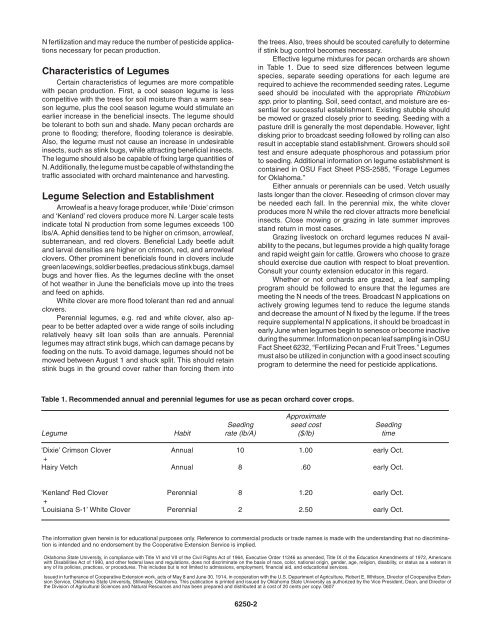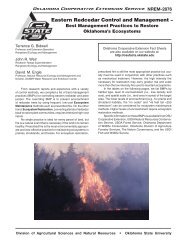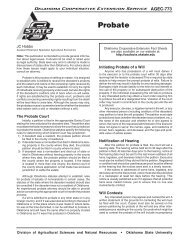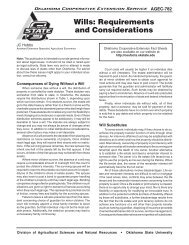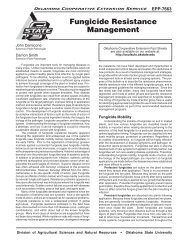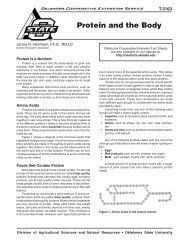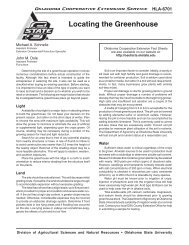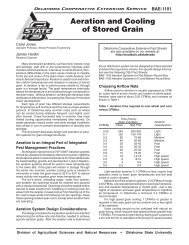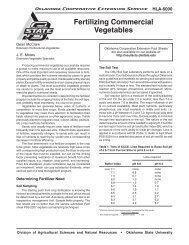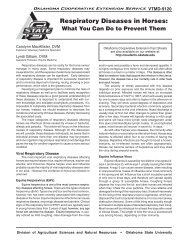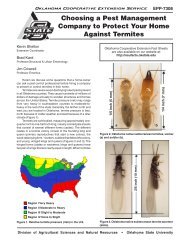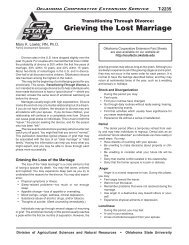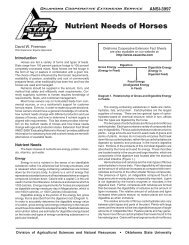Use of Legumes in Pecan Orchards - OSU Fact Sheets - Oklahoma ...
Use of Legumes in Pecan Orchards - OSU Fact Sheets - Oklahoma ...
Use of Legumes in Pecan Orchards - OSU Fact Sheets - Oklahoma ...
Create successful ePaper yourself
Turn your PDF publications into a flip-book with our unique Google optimized e-Paper software.
N fertilization and may reduce the number <strong>of</strong> pesticide applications<br />
necessary for pecan production.<br />
Characteristics <strong>of</strong> <strong>Legumes</strong><br />
Certa<strong>in</strong> characteristics <strong>of</strong> legumes are more compatible<br />
with pecan production. First, a cool season legume is less<br />
competitive with the trees for soil moisture than a warm season<br />
legume, plus the cool season legume would stimulate an<br />
earlier <strong>in</strong>crease <strong>in</strong> the beneficial <strong>in</strong>sects. The legume should<br />
be tolerant to both sun and shade. Many pecan orchards are<br />
prone to flood<strong>in</strong>g; therefore, flood<strong>in</strong>g tolerance is desirable.<br />
Also, the legume must not cause an <strong>in</strong>crease <strong>in</strong> undesirable<br />
<strong>in</strong>sects, such as st<strong>in</strong>k bugs, while attract<strong>in</strong>g beneficial <strong>in</strong>sects.<br />
The legume should also be capable <strong>of</strong> fix<strong>in</strong>g large quantities <strong>of</strong><br />
N. Additionally, the legume must be capable <strong>of</strong> withstand<strong>in</strong>g the<br />
traffic associated with orchard ma<strong>in</strong>tenance and harvest<strong>in</strong>g.<br />
Legume Selection and Establishment<br />
Arrowleaf is a heavy forage producer, while ‘Dixie’ crimson<br />
and ‘Kenland’ red clovers produce more N. Larger scale tests<br />
<strong>in</strong>dicate total N production from some legumes exceeds 100<br />
lbs/A. Aphid densities tend to be higher on crimson, arrowleaf,<br />
subterranean, and red clovers. Beneficial Lady beetle adult<br />
and larval densities are higher on crimson, red, and arrowleaf<br />
clovers. Other prom<strong>in</strong>ent beneficials found <strong>in</strong> clovers <strong>in</strong>clude<br />
green lacew<strong>in</strong>gs, soldier beetles, predacious st<strong>in</strong>k bugs, damsel<br />
bugs and hover flies. As the legumes decl<strong>in</strong>e with the onset<br />
<strong>of</strong> hot weather <strong>in</strong> June the beneficials move up <strong>in</strong>to the trees<br />
and feed on aphids.<br />
White clover are more flood tolerant than red and annual<br />
clovers.<br />
Perennial legumes, e.g. red and white clover, also appear<br />
to be better adapted over a wide range <strong>of</strong> soils <strong>in</strong>clud<strong>in</strong>g<br />
relatively heavy silt loan soils than are annuals. Perennial<br />
legumes may attract st<strong>in</strong>k bugs, which can damage pecans by<br />
feed<strong>in</strong>g on the nuts. To avoid damage, legumes should not be<br />
mowed between August 1 and shuck split. This should reta<strong>in</strong><br />
st<strong>in</strong>k bugs <strong>in</strong> the ground cover rather than forc<strong>in</strong>g them <strong>in</strong>to<br />
the trees. Also, trees should be scouted carefully to determ<strong>in</strong>e<br />
if st<strong>in</strong>k bug control becomes necessary.<br />
Effective legume mixtures for pecan orchards are shown<br />
<strong>in</strong> Table 1. Due to seed size differences between legume<br />
species, separate seed<strong>in</strong>g operations for each legume are<br />
required to achieve the recommended seed<strong>in</strong>g rates. Legume<br />
seed should be <strong>in</strong>oculated with the appropriate Rhizobium<br />
spp. prior to plant<strong>in</strong>g. Soil, seed contact, and moisture are essential<br />
for successful establishment. Exist<strong>in</strong>g stubble should<br />
be mowed or grazed closely prior to seed<strong>in</strong>g. Seed<strong>in</strong>g with a<br />
pasture drill is generally the most dependable. However, light<br />
disk<strong>in</strong>g prior to broadcast seed<strong>in</strong>g followed by roll<strong>in</strong>g can also<br />
result <strong>in</strong> acceptable stand establishment. Growers should soil<br />
test and ensure adequate phosphorous and potassium prior<br />
to seed<strong>in</strong>g. Additional <strong>in</strong>formation on legume establishment is<br />
conta<strong>in</strong>ed <strong>in</strong> <strong>OSU</strong> <strong>Fact</strong> Sheet PSS-2585, “Forage <strong>Legumes</strong><br />
for <strong>Oklahoma</strong>.”<br />
Either annuals or perennials can be used. Vetch usually<br />
lasts longer than the clover. Reseed<strong>in</strong>g <strong>of</strong> crimson clover may<br />
be needed each fall. In the perennial mix, the white clover<br />
produces more N while the red clover attracts more beneficial<br />
<strong>in</strong>sects. Close mow<strong>in</strong>g or graz<strong>in</strong>g <strong>in</strong> late summer improves<br />
stand return <strong>in</strong> most cases.<br />
Graz<strong>in</strong>g livestock on orchard legumes reduces N availability<br />
to the pecans, but legumes provide a high quality forage<br />
and rapid weight ga<strong>in</strong> for cattle. Growers who choose to graze<br />
should exercise due caution with respect to bloat prevention.<br />
Consult your county extension educator <strong>in</strong> this regard.<br />
Whether or not orchards are grazed, a leaf sampl<strong>in</strong>g<br />
program should be followed to ensure that the legumes are<br />
meet<strong>in</strong>g the N needs <strong>of</strong> the trees. Broadcast N applications on<br />
actively grow<strong>in</strong>g legumes tend to reduce the legume stands<br />
and decrease the amount <strong>of</strong> N fixed by the legume. If the trees<br />
require supplemental N applications, it should be broadcast <strong>in</strong><br />
early June when legumes beg<strong>in</strong> to senesce or become <strong>in</strong>active<br />
dur<strong>in</strong>g the summer. Information on pecan leaf sampl<strong>in</strong>g is <strong>in</strong> <strong>OSU</strong><br />
<strong>Fact</strong> Sheet 6232, “Fertiliz<strong>in</strong>g <strong>Pecan</strong> and Fruit Trees.” <strong>Legumes</strong><br />
must also be utilized <strong>in</strong> conjunction with a good <strong>in</strong>sect scout<strong>in</strong>g<br />
program to determ<strong>in</strong>e the need for pesticide applications.<br />
Table 1. Recommended annual and perennial legumes for use as pecan orchard cover crops.<br />
Approximate<br />
Seed<strong>in</strong>g seed cost Seed<strong>in</strong>g<br />
Legume Habit rate (lb/A) ($/lb) time<br />
‘Dixie’ Crimson Clover Annual 10 1.00 early Oct.<br />
+<br />
Hairy Vetch Annual 8 .60 early Oct.<br />
‘Kenland’ Red Clover Perennial 8 1.20 early Oct.<br />
+<br />
‘Louisiana S-1’ White Clover Perennial 2 2.50 early Oct.<br />
The <strong>in</strong>formation given here<strong>in</strong> is for educational purposes only. Reference to commercial products or trade names is made with the understand<strong>in</strong>g that no discrim<strong>in</strong>ation<br />
is <strong>in</strong>tended and no endorsement by the Cooperative Extension Service is implied.<br />
<strong>Oklahoma</strong> State University, <strong>in</strong> compliance with Title VI and VII <strong>of</strong> the Civil Rights Act <strong>of</strong> 1964, Executive Order 11246 as amended, Title IX <strong>of</strong> the Education Amendments <strong>of</strong> 1972, Americans<br />
with Disabilities Act <strong>of</strong> 1990, and other federal laws and regulations, does not discrim<strong>in</strong>ate on the basis <strong>of</strong> race, color, national orig<strong>in</strong>, gender, age, religion, disability, or status as a veteran <strong>in</strong><br />
any <strong>of</strong> its policies, practices, or procedures. This <strong>in</strong>cludes but is not limited to admissions, employment, f<strong>in</strong>ancial aid, and educational services.<br />
Issued <strong>in</strong> furtherance <strong>of</strong> Cooperative Extension work, acts <strong>of</strong> May 8 and June 30, 1914, <strong>in</strong> cooperation with the U.S. Department <strong>of</strong> Agriculture, Robert E. Whitson, Director <strong>of</strong> Cooperative Extension<br />
Service, <strong>Oklahoma</strong> State University, Stillwater, <strong>Oklahoma</strong>. This publication is pr<strong>in</strong>ted and issued by <strong>Oklahoma</strong> State University as authorized by the Vice President, Dean, and Director <strong>of</strong><br />
the Division <strong>of</strong> Agricultural Sciences and Natural Resources and has been prepared and distributed at a cost <strong>of</strong> 20 cents per copy. 0607<br />
6250-2


